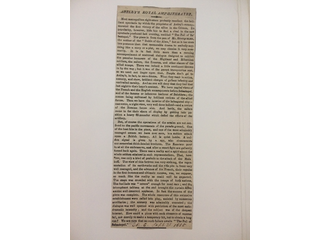Transcription
ASTLEY’S ROYAL AMPHITHEATRE.
Most metropolitan sight-seers probably recollect the brilliant spectacle by which the proprietor of Astley’s commemorated the first victory of the allies in the Crimea. Its popularity, however, buds fair to find a rival in the new spectacle produced last evening, entitled “The Fall of Sebastopol.” The piece is from the pen of Mr. STOCQUELER, the author of the “Battle of the Alma,” but as it has even less pretence than that memorable drama to embody anything like a story or a plot, we may dismiss it very summarily. It is in fact little more than a running accompaniment of scattered dialogue designed to exhibit the peculiar humours of the Highland and Hibernian soldiers, the sailors, the Zouaves, and other classes of the allied troops. There was indeed a little sentiment thrown in by the way; but it was of the purest transpontine sport, so we need not linger upon that. People don’t go to Astley’s, in fact, to see drama. What they want is action, scenery, and show, brilliant charges of gallant infantry and unrivalled cavalry. And no one will deny that they had that last night to their heart’s content. We have capital views of the French and the English encampments before Sebastopol, and of the famous or infamous harbour of Blaklava; the scenes being enlivened by brilliant reviews of the allied forces. Then we have the interior of the beleaguered city—one scene, a night view, very well done indeed—and a review of the Russian forces also. And lastly, the sailors come in for their share of display by getting into position a heavy 68-pounder which defied the efforts of the artillery.
But, of course the operations of the armies are not confined to the pacific movements of the parade ground. One of the best hits in the piece, and one of the most admirably managed scenes we have ever seen, is a sudden attack upon a British battery. All is quiet inside. A sudden signal is given by a spy, who circumvents our somewhat thick-headed brethren. The Russians pour in at all the embrasures, and after a smart fight are gallantly forced back again. There was a reality and a spirit about the whole seldom attained in such representations. That, however, was only a kind of prelude to the attack of the Malakoff. The view of this fortress was very striking, the representation of its earthworks and the rifle pits in front very well managed, and the advance of the French, their repulse in the first instance and ultimate success, was, we suppose, as much like the reality as could well be expected. The stage was crowded with the troops of both nations, The fusillade was “severe” enough for most ears; and the triumphant tableau at the end brought the curtain down amidst well deserved applause. In fact the success of the piece was complete. The whole resources of this extensive establishment were called into play, assisted by numerous auxiliaries; the scenery was admirably executed; the dialogue was well spotted with patriotism of the most melodramatic intensity; and the subject was of the deepest interest. How could a piece with such elements of success fail, not merely to make a temporary hit, but to obtain a long run! We are sure that no such failure awaits “The Fall of Sebastopol.”
